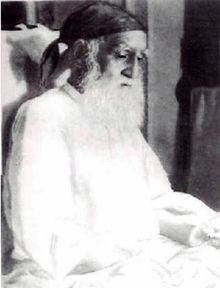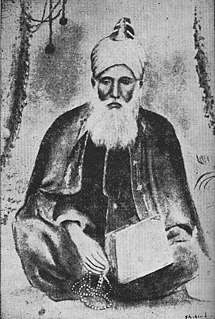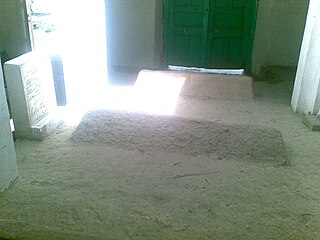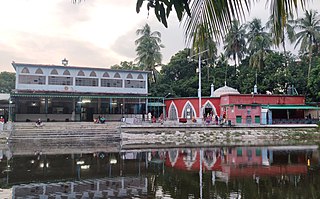Related Research Articles

Muhammad Nizamuddin Auliya, also known as Hazrat Nizamuddin, and Mahbub-e-Ilahi was an Indian Sunni Muslim scholar, Sufi saint of the Chishti Order, and is one of the most famous Sufis from the Indian Subcontinent. His predecessors were Fariduddin Ganjshakar, Qutbuddin Bakhtiyar Kaki, and Moinuddin Chishti, who were the masters of the Chishti spiritual chain or silsila in the Indian subcontinent.

Meher Ali Shah, was a Sufi scholar and a mystic Punjabi poet from Punjab, British India belonging to the Chishti order. He is known as a Hanafi scholar leading the anti-Ahmadiyya movement. He wrote several books, most notably Saif e Chishtiyai, a polemical work criticizing the Ahmadiyya movement of Mirza Ghulam Ahmad.

Park Circus is a neighbourhood of Central-South Kolkata, in Kolkata district, West Bengal, India.

Sufism has a history in India evolving for over 1,000 years. The presence of Sufism has been a leading entity increasing the reaches of Islam throughout South Asia. Following the entrance of Islam in the early 8th century, Sufi mystic traditions became more visible during the 10th and 11th centuries of the Delhi Sultanate and after it to the rest of India. A conglomeration of four chronologically separate dynasties, the early Delhi Sultanate consisted of rulers from Turkic and Afghan lands. This Persian influence flooded South Asia with Islam, Sufi thought, syncretic values, literature, education, and entertainment that has created an enduring impact on the presence of Islam in India today. Sufi preachers, merchants and missionaries also settled in coastal Gujarat through maritime voyages and trade.

Sayyid Sāhib Ḥusayni, was a famous Sufi saint from Hyderabad State, India and had a great influence over spiritual developments in the Deccan area. He belonged to Qadiri Order, and was a great proponent of the concept of Wahdat al-Shuhood.
Ata Hussain Fani (1816–1893), also known as Ata Hussain Gayavi or Haji Ata Hussain Chishti Monami Abulolai, was a Sufi saint of the Chisti Order in South Asia. He was the first Sufi to go into the completely non-Muslim locality of Gaya and spread Islam. He was also a writer, poet, linguist, and orator. He died as the Ghaus, which is the highest degree of spirituality a Sufi could attain in his time.

Shah Niyaz Ahmad was a Sufi poet from India.

Waris Ali Shah (1817–1905) was a Sufi saint from Dewa, Barabanki, India, and the founder of the Warsi Sufi order. He traveled to many places specially Europe and the west and admitted people to his spiritual order. He belongs to the 26th generation of Hazrat Imam Hussain A.S His shrine is at Dewa, India.
Muhammad Amjad, was a legal scholar of Qur'an, Hadith, and the Hanafi school of Islamic law.
A Dargah is a Sufi shrine built over the grave of a revered religious figure, often a Sufi saint. Local Muslims visit the shrine known as ziyarat. Dargahs are often associated with Sufi meeting rooms and hostels, known as khanqah. They often include a mosque, meeting rooms, schools (madrassas), residences for a teacher or caretaker, hospitals, and other buildings for community purposes. The term is derived from a Persian word which can mean, among other uses, "portal" or "threshold". Many Muslims believe that dargahs are portals by which they can invoke the deceased saint's intercession and blessing.

Hazrat Mawlana Pir Fazal Ali Shah Qureshi was an Islamic scholar and the leading Naqshbandi Shaikh of colonial India in the early twentieth century. He was born to Murad Ali Shah in 1270 AH in Daud Khel, Punjab, and died at 84 in the first night of Ramadan 1354 AH and was buried at Miskeenpur shareef, district Muzaffargarh, Punjab.

Sultan Syed Shah Mutaharuddin Suhrawardi (969–1039), also called Dada Hayat Mir Qalandar or Nathar Wali or Nadir Shah, was a Muslim mystic and preacher from the Middle East who migrated to Tamil Nadu in the 11th-century, where he travelled from area to area to preach the faith of Islam to the locals. He came to Trichy in the 11th century; his shrine is located in Tiruchirapalli, Tamil Nadu, which according to legend is atop the grave of the three-headed Hindu demon Tiriasuran whom Dada killed.
Syed Shah Murshed Ali Alquadri Al Jilani, commonly known as “Maula Pak” and “Huzur Purnoor”, is one of the pioneers of Quaderia order in Bengal. He was the 19th direct descendant of Piran -i- Pir Dastagir Syedena Ghausul Azam.

Syed Rashid Ahmed Jaunpuri (1889–2001) was a Sufi saint, author, scholar of Hadith and Quran, and Muslim missionary in Bangladesh. He was influenced by Ala Imam Ahmed Raza Khan Qadri and his Ahle Sunnat Barelvi mission He was also a poet of Urdu ghazals, nazm, hamd and naat, his pseudo name being Fani. As a Sufi master he was initiated in Qadiriyya, Chishti, Naqshbandi, Naqshbandiyya-Mujaddidiyya, Shadhili, Uwaisi, Qalandariyya, Saberiyya and Nizamiyya orders.

Sufism in Bangladesh is more or less similar to that in the whole Indian subcontinent. India, it is claimed, is one of the five great centers of Sufism, the other four being Persia, Baghdad, Syria, and North Africa. Sufi saints flourished in Hindustan (India) preaching the mystic teachings of Sufism that easily reached the common people, especially the spiritual truth seekers in India. Sufism in Bangladesh is also called pirism, after the pirs or teachers in the Sufi tradition.

Naqshbandia Silsilah, a Sufi order, was spread in India by two Sufi saints and formed two chains or lineages. One chain is linked with Shaykh Ahmad Sirhindi who is also described as Mujaddid Alf Thaani ; his chain is called Naqshbandia Mujaddidia. The other chain was associated with his contemporary Sufi saint Syedna Ameer Abul-Ula Ahrari. A resident of Agra, Ameer Abul-Ula was a descendant of the Sufi saint Khwaja Ubaidullah Ahrar. It is because of his name that this chain is known as Naqshbandia Abul-Ulaiya.

‘Abd al-Quddūs Jalāl ad-Dīn, best known as Shah Makhdum, and also known as Rupos, was a Sufi Muslim figure in Bangladesh. He is associated with the spread of Islam into the Varendra region of Bengal. He arrived in Bengal with his elder brother Syed Ahmad from Baghdad. Shah Makhdum Airport of Rajshahi, is named after him.

Khwaja Yunus Ali, also known as Khwaja Enayetpuri after his birthplace of Enayetpur in East Pakistan, was a Sufi saint. He is considered the founder of the Mujaddediya Sufi order in Bangladesh.

Ahmad Ullah Maizbhandari was a Bengali Sufi saint and founder of the Maizbhandari Sufi order in Bengal.
Shaykh Gharib Khan Nistani Afghani, popularly known as Shāh Gabru, was a 14th-century Sufi Muslim figure from the Sylhet region. Gabru's name is associated with the propagation of Islam in Osmani Nagar. In 1303, he joined Shah Jalal in the Conquest of Sylhet.
References
- ↑ Mazakera-i-Qutb-ul-Alamin,M.Ziaur Rahman Shahkupuri, Kolkata,1310 Hijri
- ↑ Gulistan-i-Quadri, Syed Mahbub Murshed, Kolkata,1946, pg 42
- ↑ Syedena Ghausul Azam, Syed Abdus Salik, Kolkata, pg 118,1939
- ↑ Gulistan,pg 41
- ↑ Walin Mursheda, Syed Shah Wali Murshed Alquadri, fol 49
- ↑ Gulistan,pg. 70
- ↑ A History of Quadria Order in West Bengal,(A thesis by) R.Anwar, Calcutta University,pg 277